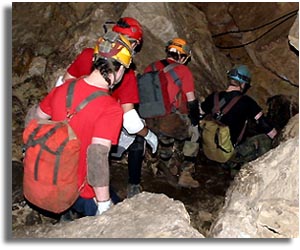|
|
|
FEBRUARY 15, 2006
 Custer, South Dakota -
Jewel Cave just got longer. Explorers recently pushed the known
length of the cave to 135 miles and ten feet after four-days spent
underground. A National Park Service cave specialist from New Mexico
joined three local Black Hills cavers at Jewel Cave National Monument
in southwestern South Dakota in this most recent push to define the
limits of this largely unexplored cave. The payoff is an untouched
wonderland of calcite rafts, thin mineral deposits that look like
water lilies; gypsum flowers with long streamers and hairs created by
wind and water; walls lined with crystals; and deep inside the cave a
mummified Townsends long-eared bat, hanging forever still and dark
from a roof filled with fossils from the even more distant past. Custer, South Dakota -
Jewel Cave just got longer. Explorers recently pushed the known
length of the cave to 135 miles and ten feet after four-days spent
underground. A National Park Service cave specialist from New Mexico
joined three local Black Hills cavers at Jewel Cave National Monument
in southwestern South Dakota in this most recent push to define the
limits of this largely unexplored cave. The payoff is an untouched
wonderland of calcite rafts, thin mineral deposits that look like
water lilies; gypsum flowers with long streamers and hairs created by
wind and water; walls lined with crystals; and deep inside the cave a
mummified Townsends long-eared bat, hanging forever still and dark
from a roof filled with fossils from the even more distant past.
“You get to see places no one has ever gone before,” said Larry
Shaffer, a computer specialist and cave volunteer from the Black
Hills Institute of Geological Research in Hill City, South Dakota.
“When you get there, it’s like Neil Armstrong stepping onto the
moon.” |
|
|
Planning to explore caves is detailed
and comprehensive. If a caver forgets flashlight batteries or other
necessities, they’re out of luck. Cavers pack light, taking only
critical equipment like head lamps and food, protein bars and special
equipment. Though the cave is a constant 49 degrees F, cavers wear
T-shirts and light clothing to increase mobility and fight the high
humidity and heat of exertion.
Explorers take from six to eight hours to travel the distance from
the cave entrance to the main camp deep inside the cave. Water is
stored along the way in plastic and nylon caches that catch drips
from the cave roof. The main camp stores 20 gallons of water, enough
to hold four people for four days. Explorers then travel another
three hours from the camp to the unexplored areas, work for six to
eight hours, and then make their way back to camp.
“We do all of our cooking and cleaning and eating over tarps so we
don’t leave anything there,” caver Andy Armstrong said, “including
human waste or garbage.” |
“I think I really like
the part that’s beyond the End,” said Andy Armstrong, a cave
management intern whose wife, Bonny, is a seasonal cave guide with
Jewel Cave National Monument. “The End was the name of the last place
people explored and so when we got beyond the End we found lots more,
like a passage 30 feet wide and 50 feet high that went on and on.”
Caving is not for everyone. Monument superintendent Todd Suess
[Cease] said the cave weeds out people not suited to the rigors of
cave exploration in the first few miles underground. “It took us an
hour and forty minutes to get through the Miseries,” said Stan
Allison, a cave specialist from Carlsbad, New Mexico. “It’s a
thousand feet of belly crawling…it’s such a long way.”
To get to the end of the eastern-most part of Jewel Cave is tough
even for hardened cavers. There are also wide high galleries where
jeweled walls reflect the light of headlamps and the going is easy.
The importance of the explorations is to get to know the cave in
intimate detail so that measures can be taken to protect the delicate
interior from activities above ground, Suess said. Other landowners
spraying herbicides could affect water in the caves, or introduce
harmful chemicals, or activities like drilling could change the
ecological balance deep underground.
And because technology cannot yet see underground, cavers use a
combination of old fashioned grit and high tech computers and lasers
to measure every inch. |
Scientists are studying
the DNA of microorganisms and chemical reactions with water in this
cave that has only one natural entrance in the Paha Sapa [PAH-ha
SAH-pah] limestone formation.
Suess said Jewel Cave is a little secret tucked away behind the
splendors of Mount Rushmore, Crazy Horse Monument, Wind Cave, Black
Hills National Forest, and Custer State Park. Cavers are welcome to
explore and over 90,000 visitors took the cave tour in 2005. Only a
handful has been past the Miseries and fewer still beyond the End.
“In my lifetime we won’t find the end of this cave and it feels
pretty good to be here,” Armstrong said.
Exploration will continue as scientists and Park managers work to
understand this lost world far below the Black Hills of South Dakota
and Wyoming. |
|
Related Links & Resources:
●
National Forests
● State Parks by
State
● National Parks Rangers
Killed In The Line Of Duty
●
National Natural
Landmarks
●
Game Wardens Killed in the Line Of Duty
●
|
| |
| |
|
|
|